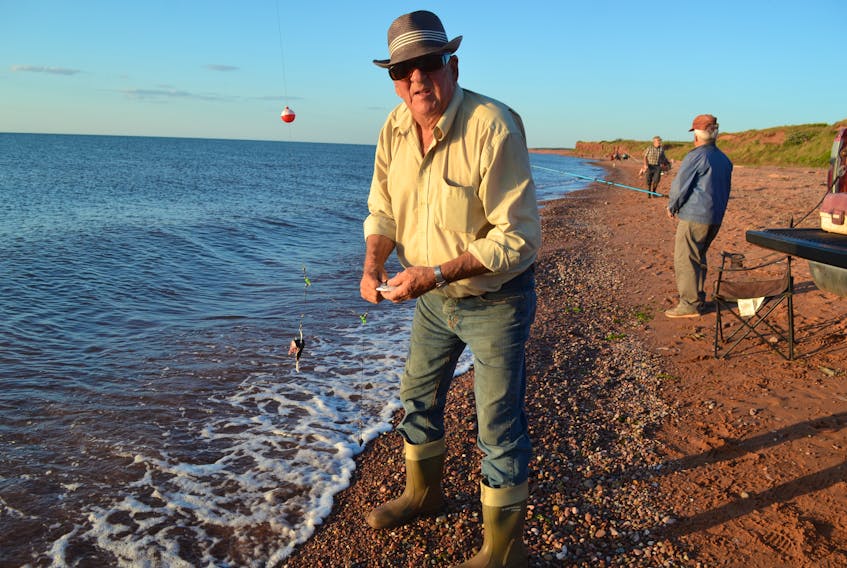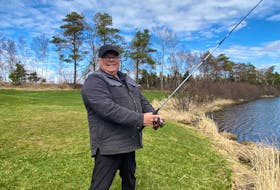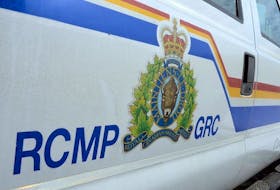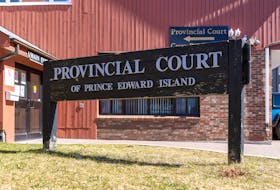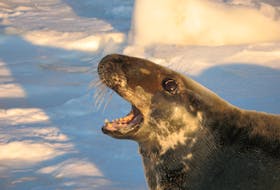CAMPBELLTON, P.E.I. — When the recreational striped bass fishery started to heat up along Prince Edward Island’s north shore last summer, Ronnie Costain made the drive to Donahue’s Shore and the Green, near Tignish, to test his luck.
And he did okay, he admits.
As it turns out, though, he could have spared himself the long drive. Ever since, he has been doing his bass fishing almost exclusively from Campbellton Beach, less than a minute’s drive from his home.
“One evening I said to (son) Rodney, ‘let’s go down and try them down here.’”
He doesn’t think anyone had ever tried fishing for bass there before.
“I think we got five that night,” he said.
Then their wives posted photos of their catch on social media.
“The next night there were about 25 rods here,” he said, while watching his line from the comfort of a lawn chair.
A crowd gathered there almost nightly all last summer and many of the fishermen reeled in the big fish.
They have been returning night after night this summer, too, but Costain says the fish just aren’t as plentiful. He’s hearing catch rates are higher on the north shore, but he is content to fish close to home.
“I think a lot of the problem is the crabs are eating the bait. If you don’t get a strike the minute your hook hits the bottom, the crabs are on it,” he said.
While he was talking, a neighbouring fisherman twice reeled in to find crabs gripping his hook.
“I think if we had a little brush of northwest wind, something fairly strong, it would drive the crabs offshore. Then we might have a better chance,” Costain says.
Apart from bringing a bass all the way to the land wash, he’s skunked in this fishing excursion. Four other groups on the beach had the same result.
“I think it depends a bit on tides, too,” he says, noting the strong full moon tides have passed.
Of course, it’s only speculation as striped bass fishing is still relatively new to the lot.
Patience, he suggests, is key.

Raymond Monaghan, whose summer home overlooks Campbellton Beach, is a model of patience. He is an avid trout fisherman, but his favourite fishing hole has been closed since last year for recovery. So, he’s trying his luck at striped bass and is still looking to reel in his first one.
“My son (Joe) got one last year and he never caught a fish in his life,” Monaghan said.
Monaghan says it never occurred to him to try fishing from shore, at least until his neighbours got the ball rolling last summer.
Having lost two rods last year and breaking a 20-pound test line to the fast-moving fish, Costain has learned to keep his rod well secured and he has upped his line to a 50-pound test.
Both fishermen agree trying their luck from the sandy beach is a good pastime.
Bass recovery
Striped bass are widely distributed throughout the southern Gulf of St. Lawrence, but the Miramichi River is its only known spawning area and is subject to additional conservation measures.
The striped bass population in the Southern Gulf of St. Lawrence had declined to the point that the Department of Fisheries and Oceans closed the commercial fishery in 1996 and the recreational and Aboriginal fishery in 2000. With the population achieving its recovery limit and recovery target by 2011, the recreational and Aboriginal fisheries were reopened in 2013.
Last year DFO granted a limited commercial licence to Eel Ground (Natoaganeg) First Nation in New Brunswick. The license has been renewed this year for up to 50,000 striped bass. A department spokesman said catches are to be reported to the department weekly and the size distribution data will be used in the management of future conservation measures for both recreational and commercial fisheries.
Statistics by DFO’s science branch found the number of striped bass spawners in the southern Gulf of St. Lawrence had declined to less than 5,000 in the late 1990s and recovered to more than 900,000 by 2017. The estimate for 2018, however, was down to 333,000 spawners.

Impact on lobster
Findings of baby lobsters in the bellies of striped bass caught by recreational fishermen and shared on social media have prompted an online discussion about the need for a commercial fishery.
Melanie Giffin, a marine biologist with the P.E.I. Fishermen’s Association, acknowledges the association is following the discussion closely, but she says the association is currently relying on Department of Fisheries and Oceans data on the size of the population.
The association, she says, is in favour of having the possibility of a commercial fishery investigated but appreciates the Department of Fisheries and Oceans needs more data before it can consider a commercial fishery.
P.E.I. Minister of Fisheries and Communities, Jamie Fox is also following the social media discussion. Last week he posted that he is interested in learning about the impact stripe bass are having on other species. He requested recreational fishermen let him know the average size of the fish they are landing and to tell him what they are finding in the fish’s stomachs. He was not available for comment on what he plans to do with the informal survey results.
Because he fillets the striped bass he hooks, Costain is relying on pictures shared by others when he suggests the fish have a healthy appetite for lobster. Whether a commercial fishery is permitted, he is confident the striped bass recreational fishery is here to stay.
Fishing for striped bass
- The season is open from April 15 to Oct. 31 in tidal waters adjacent to P.E.I., N.B. and N.S. and from April 15 to Sept. 15 in inland waters
- Fishing activity restricted to two hours before sun-up to two hours after sunset
- No license is required in tidal waters, but an angling licence from the province where the fishing activity occurs is required for inland waters
- Only fish measuring between 50 cm and 65 cm can be retained
- Non-offset barbless circle hooks are mandatory
- The daily catch limit is three legal-sized bass
- No more than three bass can be in one’s possession at any time

